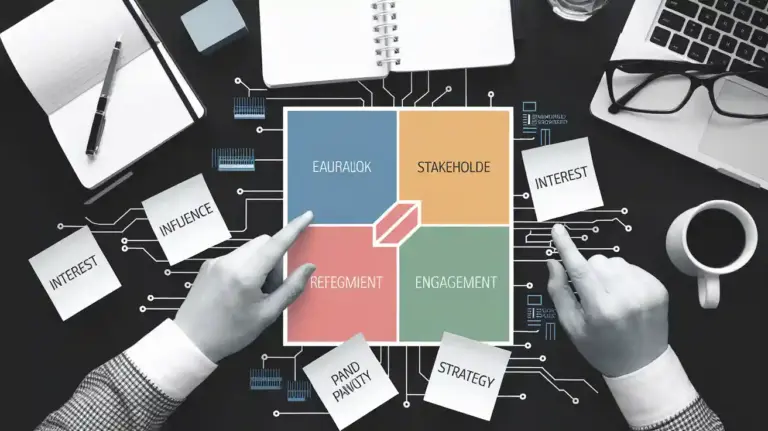Understanding who is impacted by your project or business is key to its success. The four main steps to build a stakeholder map are identifying, analyzing, mapping, and prioritizing your stakeholders and their needs. Following these steps gives you a clear view of who matters most and where to focus your attention.
A well-done stakeholder map helps you manage relationships and keep your projects on track. By looking closely at each step, you’ll learn how to spot important people and groups, figure out what they care about, visualize connections, and decide who to involve first. Learn more about the full process in this step-by-step stakeholder mapping guide.
Understanding Stakeholder Mapping
Stakeholder mapping helps you identify who is most affected by your project and how you should communicate with them. This process makes it easier to recognize different stakeholder groups and understand their interests, needs, and influence.
What Is a Stakeholder Map?
A stakeholder map is a visual tool used to organize and categorize stakeholders in your project. You will see each stakeholder or group placed based on their interest in the project and their level of influence. Most maps use a simple matrix, like a four-quadrant grid, to make this clear.
On this grid, you can quickly see which stakeholders should be kept informed, which need close management, and who might just need occasional updates. This layout helps you avoid missing key people or groups. Stakeholder mapping helps ensure no important voices are left out and supports better decision-making throughout your project.
Importance of Stakeholder Mapping
Mapping stakeholders helps you decide where to focus your communication and energy. By knowing who has the most influence or interest, your time and resources go to the right people.
If you skip this step, you might overlook powerful groups or fail to address important concerns. Stakeholder mapping reduces the risk of surprises and resistance later on. It also helps you build trust, as people notice you are paying attention to their interests.
Clear insights from a stakeholder map support smoother project progress. You can plan meetings, updates, and even changes to your project based on what each group needs or expects. Using stakeholder mapping, conflicts become easier to spot early, so you have more control over the outcome.
Common Stakeholder Map Types
You can choose from several types of stakeholder maps. The influence-interest matrix is the most common. In this type, stakeholders are rated on how much influence and interest they have. This matrix is often split into four sections so you can place groups into clear categories.
Other map types include power-impact grids and stakeholder onion diagrams. Onion diagrams show layers of stakeholder groups, with those closest to the project in the center. Each map type gives you a different way to see relationships and plan your communication.
If you want step-by-step visuals and ideas, you can review examples and templates from ProjectManager and Mural. Each method helps you tailor your stakeholder strategy to your specific project needs.
Step 1: Identifying Stakeholders
To build a stakeholder map, you first need to identify everyone who might affect or be affected by your project. This step includes learning how to find these people, knowing which groups they belong to, and understanding the differences between those inside your organization and those outside it.
Methods to Identify Stakeholders
You can use several strategies to find potential stakeholders. Start by brainstorming with your team using a whiteboard or digital tool. Go through your project documents and organization charts to spot key roles connected to your work. Include customers, suppliers, project team members, and anyone else impacted.
Interviews and surveys can also help you gather names. Speak with people in different departments to make sure you are not missing anyone. Review past project records for lessons learned about overlooked stakeholders. Visual mapping software can make this process quicker and clearer, especially for larger projects.
Another method is to categorize stakeholders by their influence, interest, or relationship to the project’s success. Group them by decision-makers, end users, and supporting staff. This way, you can be thorough and avoid missing important groups. For more on stakeholder identification techniques, see this stakeholder mapping guide.
Types of Stakeholders
Stakeholders are usually divided into two main groups: internal and external. Internal stakeholders include people within your organization. This group can contain managers, employees, project teams, and departments related to your project.
External stakeholders are people or groups that are not part of your organization but have an interest in the project. Examples are customers, suppliers, local communities, regulators, and investors. Each group may care about different outcomes.
You can organize stakeholders in a table to keep track:
| Stakeholder Group | Example Roles |
|---|---|
| Internal | Managers, Employees |
| External | Customers, Suppliers |
Understanding both types helps you tailor your stakeholder management to match each group’s needs and concerns.
Considerations for Internal and External Stakeholders
When identifying stakeholders, consider how their interests, goals, and influence differ. Internal stakeholders often have a direct impact and more involvement in project decisions. They may need regular updates or be responsible for key tasks. Consider their position, authority, and experience in similar projects.
External stakeholders might not be directly involved day to day, but their opinions can shape project direction. Laws, community interests, and market trends can play a big role. Pay attention to what information each group prefers, how often they need updates, and any cultural or regulatory concerns.
Incorporating both groups early improves communication and helps avoid missed expectations later. Collaborate and document your findings clearly to ensure no significant party is left out. For tips on balancing both groups, check this stakeholder identification guide.
Step 2: Analyzing Stakeholder Needs and Interests
Understanding stakeholder needs and interests helps you understand how different people or groups may impact your project. Accurate analysis helps you manage expectations and respond to key concerns.
Gathering Information on Stakeholder Needs
Start by collecting as much information as you can about each stakeholder. Use interviews, surveys, meetings, and emails to learn what matters most to them. Focus on identifying their main goals, fears, and expectations for the project.
Pay attention to both spoken and unspoken feedback. Some needs may be clearly stated, while others may need careful listening or observation. For example, a team member may want faster results, while a partner may be more worried about costs.
Organize your findings in a table or list for easy comparison:
| Stakeholder | Needs | Concerns |
|---|---|---|
| Team Member | Fast workflow | More support needed |
| Supplier | Timely decisions | Clear communication |
| Customer | High-quality product | On-time delivery |
This structure lets you quickly review who needs what and where there may be possible conflicts or overlaps. Taking time to gather thorough information sets the foundation for better communication.
Prioritizing Stakeholder Interests
After you identify needs, the next step is to rank stakeholder interests by importance and influence. Not every request can be fulfilled, so you must decide which ones matter most to your project’s success.
Using a tool like a stakeholder map helps you see which stakeholders have the largest impact. Stakeholders with both high influence and strong interest should be your top priority.
Create a simple list:
- High Influence/High Interest: Meet needs first
- High Influence/Low Interest: Keep informed
- Low Influence/High Interest: Listen and update
- Low Influence/Low Interest: Minimal contact
Clear priority helps you avoid wasting time, manage resources better, and focus on what truly drives your project forward. This step ensures you listen to the right people when making key decisions.
Step 3: Categorizing Stakeholders
This step focuses on sorting stakeholders by their influence, interest, and relationship to your project. Using the right model and mapping techniques helps you see who matters most and how to keep them engaged.
Applying the Salience Model
The Salience Model is a popular way to group stakeholders. This model uses three parts: power, urgency, and legitimacy. Power shows if a stakeholder can affect your project. Urgency is about how quickly you need to address their needs. Legitimacy checks if their involvement is valid or appropriate.
You place each stakeholder into one or more of these categories. Stakeholders who score high in all three areas are called “definitive stakeholders.” They need the most attention and communication. Others, who have just one or two of these traits, require less focus.
Using this model gives you a clear view of where to spend your effort. It also helps you avoid missing any important group. You can make a table like this to organize information:
| Stakeholder | Power | Urgency | Legitimacy | Category |
|---|---|---|---|---|
| Marketing Manager | High | Medium | High | Definitive |
| Customer Representative | Medium | Medium | High | Expectant |
| Local Community | Low | Low | Medium | Latent |
To learn more about how this works, visit this detailed guide on stakeholder mapping techniques.
Mapping Stakeholder Groups
After you categorize each stakeholder, you can group them on your stakeholder map. Usually, this is done with a visual matrix. One common layout is the four-quadrant map with axes for “influence” and “interest.” Important groups go in different spots, such as “high influence, high interest” or “low influence, low interest.”
Your map might include categories like “key players,” “subjects,” “context setters,” and “crowd.” Each group is managed differently. For example, key players need regular updates and feedback. On the other hand, those with low interest and influence may just need to receive main project news.
Making visual maps makes it easy to spot gaps and overlap. You quickly see which groups might be over- or under-managed. By using clear group labels, you improve communication and make your project plan easier to follow. For more practical details, check out this stakeholder mapping guide.
Step 4: Developing Engagement and Communication Strategies
After you have mapped your stakeholders and understood their needs, the next step is to create focused plans for engagement and communication. You will need to ensure that your methods for involving and updating stakeholders are clear, timely, and suited to their level of interest or influence.
Crafting a Stakeholder Engagement Plan
A stakeholder engagement plan lays out how you will interact with each stakeholder group. Start by listing each key stakeholder and deciding on the right level of engagement. This might range from simply keeping some stakeholders informed to involving others closely in decision-making.
You should set clear goals for engagement, such as building trust or gaining specific input. Use a simple table to track your plan:
| Stakeholder Group | Engagement Level | Goal | Method |
|---|---|---|---|
| Internal Team | Collaborate | Decision input | Workshops |
| Investors | Consult | Approval | Reports |
| Customers | Inform | Awareness | Newsletters |
Update this plan regularly as relationships grow or change. Review what works and adjust to keep stakeholders involved at the right level.
Designing Effective Communication Strategies
Communication strategies must be tailored to each stakeholder group. A good strategy answers three key questions: What needs to be shared? When should it be shared? How is it best delivered?
For example, updates might be best given through meetings for core project teams, but via emails or dashboards for external partners. Frequency matters, so make a schedule for communication touchpoints.
Be clear, honest, and concise in your messages. Consider using visuals, bullet points, or charts to make information easy to understand. Your communication plan should help prevent confusion and keep stakeholders on track. For more tips, you can look at guides on effective communication strategies.
Facilitating Collaboration with Stakeholders
Involving stakeholders in meaningful ways increases their sense of ownership and can lead to better results. Ask for feedback during planning sessions and encourage questions or suggestions.
You can use workshops, feedback sessions, or online tools to bring people together. Assign clear roles so everyone knows how they contribute. This helps avoid overlaps or confusion.
Track collaboration progress, and recognize contributions or concerns raised by stakeholders. When you make it easier for people to work together, you encourage trust and stronger project outcomes. Use methods described in stakeholder mapping guides to support your collaboration process.
Integrating Stakeholder Mapping into Strategic Planning

You can use stakeholder mapping to guide resource allocation, set clear priorities, and outline steps that support your organization’s long-term success. Applying mapping techniques helps you see where influence lies and how to align your actions with both stakeholder needs and organizational goals.
Using Stakeholder Maps for Decision-Making
Stakeholder maps are practical tools in the decision-making process. They help you quickly see which groups have the most influence or interest in your project or strategy. You can use these insights to predict potential challenges and address concerns early.
When you sort stakeholders by influence and interest, you know who needs regular updates and whose feedback should shape your plans. This focused approach supports quicker, more informed decisions.
At each stage, refer to your stakeholder map to check if planned actions align with stakeholder expectations. This prevents surprises and increases engagement. By making the map part of your routine, you get a clearer path through complex or fast-moving projects. For more detail on the mapping process, Miro offers a guide to stakeholder maps.
Aligning Stakeholder Management with Organizational Goals
Strategic planning works best when stakeholder management fits with your main goals. Once you have mapped stakeholders, connect each group’s influence or needs to your organization’s desired outcomes.
Start by reviewing your organization’s vision and core objectives. Then cross-check these with the interests and impact of each key stakeholder from your map. Make a simple table to visualize the match:
| Stakeholder Group | Key Interests | Organizational Goal Supported |
|---|---|---|
| Investors | High returns | Financial growth |
| Customers | Quality and value | Brand reputation |
| Employees | Job security, culture | High performance |
Adjust stakeholder engagement plans so that each action supports one or more company goals. This keeps efforts focused and helps avoid wasting resources. A clear alignment lets you manage risks, gain buy-in, and increase the chances of meeting targets. For more on this approach, see Mural’s stakeholder map creation steps.
Maintaining and Evolving the Stakeholder Map
Your stakeholder map should not remain static because stakeholder relationships often change. You need to keep your map up to date so it reflects current interests, concerns, and influences.
Monitoring Stakeholder Relationships
Regularly monitor how your stakeholders feel about the project. Use surveys, direct conversations, or feedback forms to understand their opinions and concerns. Pay attention to changes in influence or interest so you can adjust your approach.
Set reminders to check in on key relationships every few weeks or months, depending on your project’s pace. It helps to track specific issues or trends. Create a simple table or checklist to log:
| Stakeholder Name | Last Contact | Current Interest | Current Influence | Notes |
|---|---|---|---|---|
| Example Corp | 2 weeks ago | High | Moderate | Wants more updates |
By keeping close tabs on these details, you can spot and address any problems before they grow.
Updating the Stakeholder Map
Whenever you notice a shift in stakeholder attitudes, priorities, or influence, update your map. Add new stakeholders as they become involved, and remove those who are no longer relevant. Make sure to adjust categories such as power and interest when changes happen.
Review the map after milestones, big decisions, or team changes. A routine update, even during quiet periods, keeps your map accurate and useful. Keeping historical notes also helps you track patterns and respond to recurring issues. For tips on mapping and prioritizing, this guide offers a clear step-by-step approach.
Frequently Asked Questions
You can use practical steps and tools to identify, prioritize, and engage your stakeholders. Visual templates and clear mapping methods make the process easier for different projects.
How can one identify stakeholders when creating a stakeholder map?
You should start by listing all people, groups, or organizations who can impact your project or who are affected by it. This includes team members, customers, suppliers, leaders, and community groups. Look at anyone who has an interest or influence in your project’s results. For more detail, see this step-by-step stakeholder mapping guide.
What methods are recommended for prioritizing stakeholders in a map?
Most teams use an influence-interest matrix. This method places stakeholders in one of four quadrants based on their level of influence over the project and their interest in it. This helps you know who needs the most attention. Learn more about these methods in this guide to stakeholder mapping.
Can you outline the process for engaging different levels of stakeholders?
Start by communicating often with stakeholders who have high influence and interest. Keep them updated and consult them for feedback. For those with lower influence or interest, you can involve them with occasional updates or by listening to their concerns. Adjust your communication style based on their level of involvement.
What tools are available for generating a stakeholder map effectively?
Several online tools and templates can help you build and share a stakeholder map. Digital whiteboards and project management software often include templates and drag-and-drop features to make visual mapping simple. Examples of these tools can be found in this stakeholder mapping guide.
Which templates might be used for visualizing stakeholders in a project?
Common templates include the four-quadrant influence-interest matrix and stakeholder analysis grids. Many project management platforms offer built-in templates that you can customize to match your project’s needs. These templates allow you to arrange stakeholders based on their role, influence, or interest.
How should the results of a stakeholder mapping exercise be analyzed?
After mapping, look for patterns or gaps in stakeholder involvement. Review which stakeholders hold key positions and who might need more attention. Use the map to plan your communication and engagement strategies, making sure all important voices are included.





